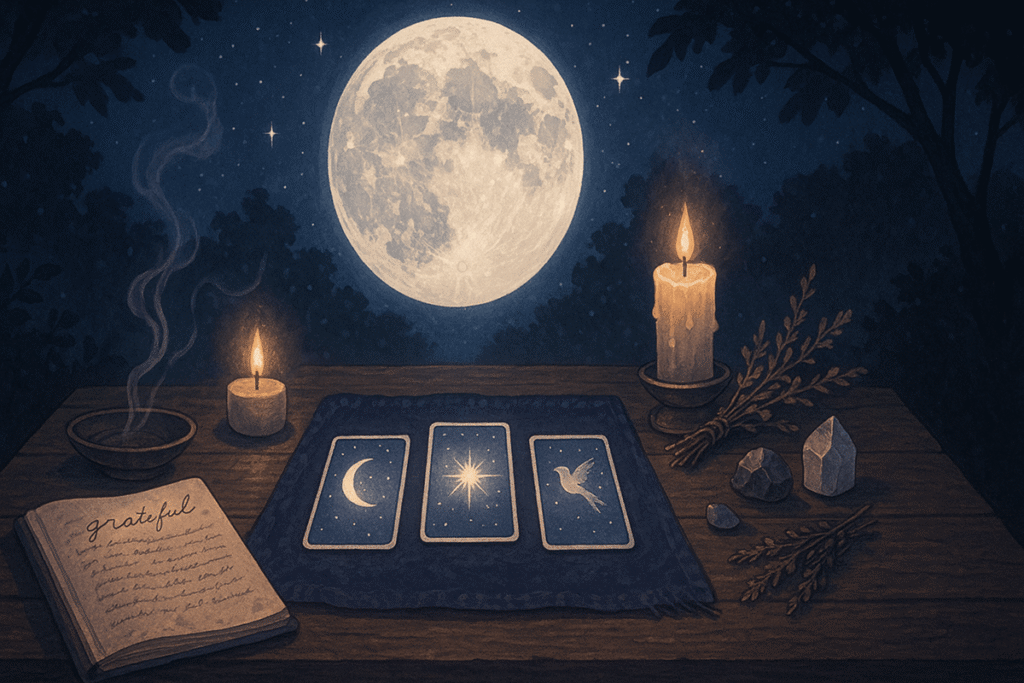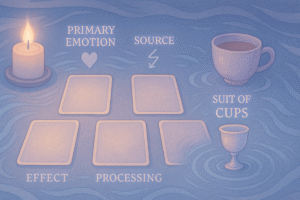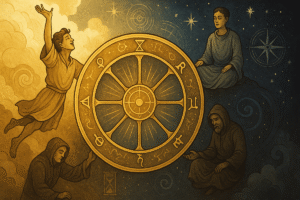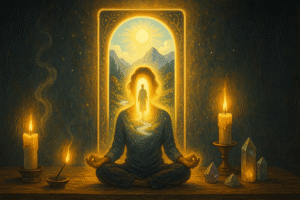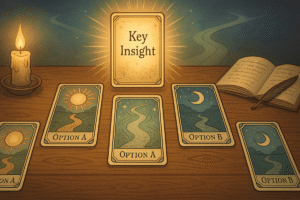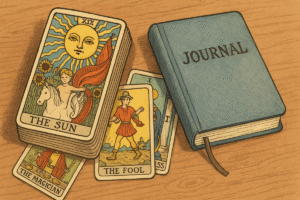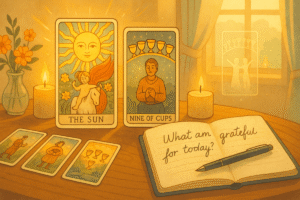Table of Contents
There’s something about full moon energy that makes me want to pause everything. Maybe it’s the brightness, or maybe it’s just knowing that something has reached its peak. Either way, I’ve found that full moons feel like natural stopping points, little markers in time where you can look around and take stock of things.
A full moon tarot ritual isn’t about predicting what’s coming next. It’s more like holding up a mirror to this particular moment and asking yourself what you’re carrying, what you’ve accomplished, and what might be ready to move on. I think of it as a practice in noticing rather than forecasting.
Why the Full Moon Matters for Reflection
The full moon has been linked to completion and culmination across different cultures for centuries. When the moon is full, it’s at its brightest and most visible. That symbolism translates pretty naturally into our inner lives. What has been building? What has finally shown itself? What feels finished?
I like working with tarot during this time because the cards help me articulate things I might not have words for yet. Sometimes I pull a card and realize I’ve been avoiding thinking about something. Other times, a card confirms what I already suspected but hadn’t fully acknowledged. The ritual structure gives me permission to sit with these questions instead of rushing past them.
Perhaps the most valuable thing about doing this regularly is that it creates a rhythm. You start to see patterns in your own growth. What you released six months ago might feel completely irrelevant now. What felt impossible last full moon might have quietly resolved itself. The ritual becomes a form of documentation, a way of honoring your own process.
Setting Up Your Space
You don’t need much for this. I usually clear off a small table or even just a corner of my desk. Some people like candles, and I’ll admit the atmosphere helps, but it’s not required. What matters more is creating a sense of intentionality, a feeling that you’re stepping slightly outside of your regular routine.
If you want to include any elements that feel meaningful to you, go ahead. Maybe it’s a crystal you’ve had for years, or a plant, or even just a cup of tea you only drink during these moments. I’ve done this ritual with elaborate setups and I’ve done it sitting cross legged on my bedroom floor with just my deck. Both worked fine.
The key is to minimize distractions. Turn your phone to silent. Let anyone you live with know you need fifteen or twenty minutes. This practice works best when you can really sink into it without half your attention somewhere else.
The Three Card Spread for Release and Gratitude
This spread uses three positions, and each one serves a different purpose in helping you work with the full moon’s energy of completion.
Position One: What has come to fruition this cycle?
This card asks you to look back over the past lunar cycle, or even just the past few weeks, and identify what has materialized or developed. It might be something tangible, like finishing a project, or something more subtle, like a shift in how you approach a relationship. The question isn’t asking you to evaluate whether the outcome was good or bad. It’s simply asking you to recognize what has emerged.
When I pull this card, I try to stay open to unexpected answers. Sometimes what has “come to fruition” isn’t what I was consciously working toward at all. Maybe I was focused on a work goal, but the card points to an emotional realization instead. That’s useful information. It tells me where my actual energy has been going, versus where I thought it was going.
Position Two: For what am I most grateful?
Gratitude practices can sometimes feel forced, but this card position helps make it more specific. Instead of trying to generate a general feeling of thankfulness, you’re using the card as a prompt. What is this image showing you? What does this particular archetype or symbol make you think of when you hold the question of gratitude?
I find this position especially grounding. It’s easy to get caught up in what’s not working or what still needs attention. This card gently redirects that focus. Even if the card that appears seems challenging at first, there’s usually something in it worth appreciating. A difficult card might point to a lesson learned, or resilience you didn’t know you had, or even just the fact that you survived something hard.
Position Three: What is now complete and ready to be let go of?
This is the release position, and it’s often the one that brings up the most emotion. Letting go is complicated. Even when something isn’t serving us anymore, there can be resistance to releasing it. This card doesn’t tell you what will happen if you let go. It just asks you to consider what might be finished.
The card here might point to a habit, a belief, a relationship dynamic, or even just a way of thinking about yourself that’s become outdated. I try not to force an immediate answer. Sometimes I pull this card and don’t fully understand it until days later. That’s okay. The question has been planted, and my mind keeps working on it in the background.
How to Read the Cards Reflectively
Reading these cards isn’t about finding the “right” answer. You’re not looking for a single correct interpretation that unlocks everything. Instead, you’re having a conversation with yourself, using the cards as prompts.
Start by just looking at the imagery. What stands out? What feeling does the card give you before you even think about traditional meanings? I usually spend a minute or two just observing before I reach for any reference material.
Then, consider how the card’s symbolism might relate to your question. If you pulled The Hermit for “What has come to fruition,” maybe it’s pointing to increased self reliance or a period of necessary solitude that’s now bearing fruit. If you pulled the Three of Cups for “What am I grateful for,” perhaps it’s highlighting community or celebration or the support of friends.
The important thing is to make the reading personal. Generic card meanings can give you a starting point, but the real insight comes when you connect those meanings to your actual life. What does this card mean for you, right now, in this specific context?
Working With What Comes Up
Sometimes this ritual feels clarifying and peaceful. Other times, it brings up things I wasn’t expecting to deal with. Both experiences are valid. If a card hits on something uncomfortable, that’s not a sign you did it wrong. It might mean you’ve touched on something important.
I keep a journal specifically for these full moon readings. Writing after I pull the cards helps me process what came up. I don’t worry about making it coherent or beautiful. I just write what I’m thinking, what surprised me, what made sense, what I’m still confused about.
Looking back at these entries months later is always interesting. I can see which releases actually happened and which ones I’m still working on. I can see what I was grateful for and whether that gratitude has deepened or shifted. The journal becomes a record of growth that I wouldn’t have otherwise.
Making It Your Own
This three card spread is a framework, not a rule. If you want to add a fourth position asking “What support is available to me?” or “How can I honor this completion?”, do that. If you want to pull a clarifying card for any position that feels unclear, that’s fine too.
Some people like to do this ritual at the exact time of the full moon. Others just do it sometime during the day or two when the moon is fullest. I don’t think the timing matters as much as the intention. What matters is that you’re showing up and creating space for reflection.
You might also want to incorporate other practices that feel meaningful. Maybe you write down what you’re releasing and then burn the paper, or tear it up, or bury it. Maybe you light a candle and let it burn all the way down as a symbolic completion. These additions can deepen the ritual, but the core practice works even without them.
Closing Thoughts on Ritual and Rhythm
I think what I appreciate most about this practice is how it creates a gentle structure for self examination. Without it, I’d probably just move from one thing to the next without pausing to notice what’s actually happening in my life.
The full moon comes around every month, which means this ritual becomes a regular checkpoint. You don’t have to wait for New Year’s or a birthday or some major life event to reflect. You have a built in rhythm, a monthly invitation to look at where you are and what you’re carrying.
And perhaps more than anything, this ritual reminds me that completion is just as important as beginning. We’re often so focused on starting new things, setting new goals, making new plans. But finishing things, acknowledging what’s done, releasing what’s no longer needed… that deserves attention too. The full moon tarot ritual creates space for exactly that kind of attention.
Frequently Asked Questions
Do I have to do this ritual exactly on the full moon?
Not at all. While the full moon itself is ideal, you can practice this ritual anytime during the few days before or after the full moon when the energy still feels full and bright. Some people prefer doing it when the moon is at its exact peak, while others choose whenever they feel most called to reflect during that window. What matters most is your intention and presence, not perfect timing.
What if I pull a card that doesn’t make sense or feels confusing?
This happens more often than you might think, and it’s completely normal. If a card feels unclear, spend some time just sitting with the imagery without trying to force meaning. Sometimes the answer reveals itself hours or even days later. You can also journal about why the card might feel confusing or pull an additional clarifying card. Trust that confusion itself can be valuable information, it might be pointing to an area where you need more time to understand what’s happening.
Can I do this ritual if I’m completely new to tarot?
Absolutely. This three card spread is actually perfect for beginners because the questions are straightforward and personal. You don’t need to be an expert in traditional card meanings. Start by noticing what you feel when you look at each card, what images or colors stand out, and how the card makes you feel before you look up any meanings. Your personal response to the cards is just as valid as any textbook interpretation.
What should I do with the cards after the reading?
There’s no single right answer here. Some people like to leave the cards out for a day or two to continue reflecting on them. Others take a photo for their journal and then shuffle the cards back into their deck. You might also want to pull the same spread next full moon to see how things have shifted. The important part is what you do with the insights, not what you do with the physical cards themselves.

